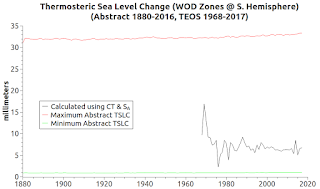 |
| Fig. 1a |
 |
| Fig. 1b |
 |
| Fig. 1c |
I. Brief Background
Thanks to Josiah Willard Gibbs I can use the TEOS-10 Org toolkit in Dredd Blog software modules and then share the results.
For today's graphs I used the latest World Ocean Database and SOCCOM data so that we can take another look at the thermal expansion hypothesis (On Thermal Expansion & Thermal Contraction, 2, 3, 4, 5, 6, 7, 8, 9, 10, 11, 12, 13, 14, 15, 16, 17, 18, 19, 20, 21, 22, 23, 24, 25, 26, 27, 28, 29, 30, 31, 32, 33).
Today's graphs are based upon in situ temperature & salinity measurements (taken at the same depth and location at the same time).
The measurements are taken at up to 33 depths, then averaged together.
Before the averaging is done, however, the in situ measurements are used to calculate the TEOS-10 values of Conservative Temperature (CT) and Absolute Salinity (SA) as shown by example: here.
The difference between that example and today's graphs is that today's graphs are calculated from over a billion measurements that have, over the years, been stored in the WOD and SOCCOM datasets.
 |
| Fig. 2a |
 |
| Fig. 2b |
 |
| Fig. 2c |
II. Today's Graphs
Today, there are three sections of graphs.
The Fig. 1a - Fig. 1c section concerns the Northern Hemisphere (NH), the Fig. 2a - Fig. 2c section concerns the Southern Hemisphere (SH), and the Fig. 3a - Fig. 3c section is the combined (averaged) values of the NH and SH (result is the Global Mean Average).
III. Presentation Details
The "a" graphs feature in situ salinity (SP) and the TEOS-10 calculated Absolute Salinity (SA).
The "b" graphs feature in situ temperature (T) and the TEOS-10 calculated Conservative Temperature (CT).
Note that the T and CT lines ("b" graphs) are virtually identical at this resolution, but the SP and SA lines ("a" graphs) differ by a small amount.
The old way of determining "salinity" was to measure how an electrical current would travel through the liquid sample, while the new way determines the mass of non-sea-water molecules in the liquid (that is why the word "conductivity" is used in the "a" graphs to express that measurement type, and why "g/kg" expresses the TEOS measurements).
The "c" graphs are calculations of thermal expansion and contraction of the sea water (What every oceanographer needs to know about TEOS-10, PDF).
A simple example showing how the TEOS-10 toolkit functions are used is shown in the Dredd Blog post "The Art of Making Thermal Expansion Graphs".
 |
| Fig. 3a |
 |
| Fig. 3b |
 |
| Fig. 3c |
IV. The Boundaries
The graphs all contain boundary lines that express the WOD oceanographer's maximum and minimum values for each ocean area and depth.
Those two lines are at the top and bottom of each graph.
Those basic boundary values are found in the WOD Manual.
I use those maximum and minimum values to illustrate where current characteristics fit, and how they have changed over several decades.
V. Conclusion
The TEOS-10 toolkit helps us to grasp the vastness of the world oceans, and what is taking place in them.
The time for believing that thermal expansion and contraction is "the" major cause (or even "a" major cause) of sea level change has passed.
The time for measuring the values of sea water, in terms of what temperatures are involved in melting the many tidewater glaciers of the world, is now (Hot, Warm, & Cold Thermal Facts: Tidewater-Glaciers, 2, 3, 4).
And in closing, I will say that the time for realizing how many glaciers are being melted down in the deeper depths is also right now (Antarctica 2.0, 2, 3, 4, 5, 6 [& supplements A, B, C, D, E, F]; Greenland 2.0, 2).
The next post in this series is here, the previous post in this series is here.
 |
| (This is what tidewater glacier melt is doing to sea level.) |
No comments:
Post a Comment